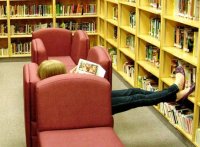Do Your Students Read Critically?
Your content has been saved!
Go to My Saved Content.How do you tell if someone has been reading a book critically? One way is they have dog-eared the pages, underlined key ideas, annotated the margins, highlighted quotable phrases, and filled the book with tabs on pages of interest.
Looking closer, you read the notes in the margin and you see that in some cases the notes indicate agreement with the author, other notes simply add supporting references, while others vehemently disagree and give examples and evidence contradicting what is written.
If you find such a book, you can be sure that the reader not only read it, but did so critically. As educators, the best thing we can do is to help students develop the skills for critical reading and establish critical reading as a "habit of mind."
Questioning Text
Critical reading means that not only does the reader read to obtain the content knowledge (what information or message the author is sharing), but additionally, the reader has to read for a level of understanding through which he or she can evaluate the writing. Critical reading requires the reader to ask the hard questions: "Do I believe what I am reading?" "Does it make sense?" "Is the argument compelling?" "Is the evidence provided sufficient and credible?" "What is missing?" "What is most important?" "How does this fit with what I already know?" "How is this useful to me?" "What do I need to do with this information?" When students read critically, information in the book comes alive and they remember what they read.
In these margin conversations with the author, the student asks questions that seek more evidence, understanding or examples. The student also makes "to do" notes to himself of the need to look for more information online, to refer to the dictionary, to check facts, or to talk to someone about this topic. Some of the questions go unanswered; "Why do you bring this up?" "How does this fit in?" "What were you thinking?" "Where is your evidence?" Some of the margin notes are simply exclamations of support: "Good thinking!" "That's right!" "Awesome!" "Great idea," while others are pejorative labels: "That is stupid!" "Seriously?" "Wrong!" "Get a grip!" "No way!"
Books that are critically read also contain non-linguistic stars, circles, happy faces, sketches, and highlighted or underlined phrases that identify critical topics that the students would like to reference in the future.
Sticky tabs mark pages of importance and Post-it notes stuck to the pages add additional information or questions. Even electronic books can be marked on. The iBooks not only have a note section, but highlighted words and phrases are automatically saved in electronic note-cards with the word or phrase on one side and a blank card face for writing the definition on the other. After going back and defining the highlighted words or phrases, the student would then be able to quickly review the important concepts of a chapter as if it were a stack of three-by-five cards.
Unfortunately, public schools do not allow students to write in their books, so even when students get to college and have to buy their books, they feel that writing in the books is a sin.
Worst of all, they do not have any experience in "reading with a pen in hand" as noted by school reform agent Dr. Michael Schmoker (2006) in his book, Results Now. There are ways around this, post-it notes for example and note pads, but there is nothing that beats recording your conversation with the author right in the book itself.
Digital Annotation
My school has promoted the use of the iPads, and with these tools, finally, we may be able to fill the critical reading void and help our students develop the essential habit of mind of critically reading everything.
With electronic books, students will be able to write notes connected with the pages they read and will easily be able to search, categorize, and collate their notes. More importantly, however, the students will be able to have those critical conversations with the author that will engage them in what they are reading, deepen their understanding, and most importantly of all, and following the lead of Dr. Daniel Willingham, a noted cognitive scientist, who states, "The residue of thought is memory," students will assimilate and remember what they read.
What kind of critical conversations do your students have with the authors or textbooks they read? Please share in the comment section below.
